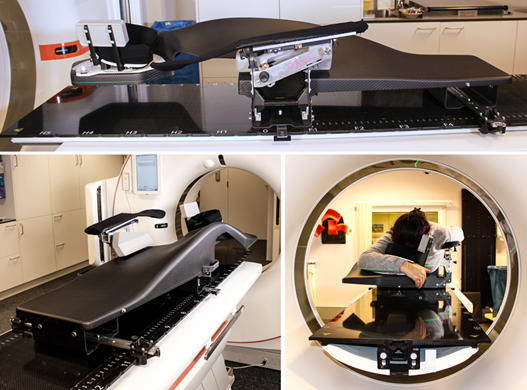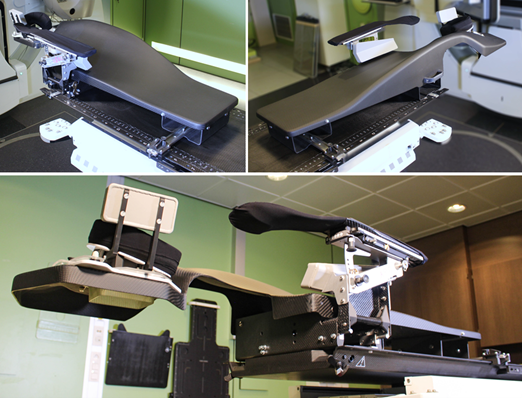Breast cancer patients commonly receive radiotherapy in the supine position, lying face-up. Randomized studies have shown that treatment in the prone position for breast cancer reduces acute toxicity and cosmetic changes. Prone breast treatment helps to reduce radiation exposure to surrounding organs and tissues, particularly the heart and lungs. This may lower the risk of complications, such as future heart disease and lung cancer. Furthermore, breast motion due to respiration is reduced in the prone position, helping to improve treatment accuracy and facilitating deep inspiration breath hold techniques to minimize heart and lung dose.
The OABC is designed for prone breast cancer treatment. Its application range includes whole breast, partial breast and breast- and regional lymph node radiotherapy. Placing the patient on the OABC exploits gravity to increase separation of breast and regional lymph nodes from critical organs at risk. This means that radiation exposure of the heart, lung and surrounding healthy tissue may also be minimized in prone irradiation of thoracic wall + regional lymph node regions or of regional lymph nodes alone.
A distinguishing feature of using the OABC is exposure of the patient’s breast shoulder and upper sternal regions that provides open access to the breast and regional lymph nodes including the internal mammary chain. Since the beam path passes through the breast and regional lymph nodes without couch interference, scattering may be minimized while build-up in skin remains intact. The exposure facilitates precise positioning by floor laser projection directly on the skin overlaying the target region.


The left picture illustrates the range of open access to the breast and regional lymph nodes. The right picture illustrates the use of an underneath positioning laser projecting directly to the breast and regional lymph nodes. “Reference publication “Radiat Oncol. 2017 May 26;12(1):89”
The OABC is provided as a completely assembled unit for left or right-side breast cancer radiotherapy. A build-in pedestal, raises the patient at mid-sternum approximately 17.5 cm above the zero position of the couch surface of a CT-simulator couch. More elevation can be obtained by the accessory “Couch Adapter Frame”. Elevation of the patient allows for seamless transition from CT-simulation to treatment. Reactive forces to the patient’s weight are similar at CT-simulation and treatment. Hence, device deformation under patient load is CT-simulated.
The left- or right-side OABC are available for use on the radiotherapy treatment couch on which they are precisely aligned through a transverse positioning bar (cranial) and secured by a transverse clamping bar (caudal).

OABC-L mounted on a Siemens Healthinaers CT-simulator equipped with a couch top of the Varian SGRT Exact type.
Above: ipsilateral view.
Below left: contralateral view.
Below right: view through the CT-simulator bore”

OABC-L mounted on a an Elekta linear accelerator couch top of the i-Beam type as a couch extension.
Above left: ipsilateral view.
Above right: contralateral view.
Below: illustration of the “open access” when mounted as a couch extension.

